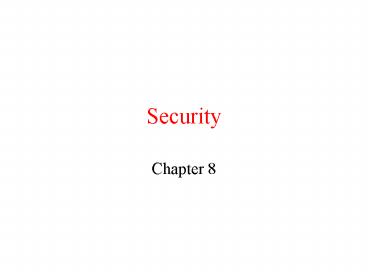Security - PowerPoint PPT Presentation
1 / 46
Title:
Security
Description:
Digital Signatures (1) Digital signing a message using public ... Digital Signatures (2) Digitally signing a message using a ... A playground. 8-28 ... – PowerPoint PPT presentation
Number of Views:26
Avg rating:3.0/5.0
Title: Security
1
Security
- Chapter 8
2
Types of Threats
- Interception
- Unauthorised party gains access
- Interruption
- Services or Data become unavailable
- Modification
- Unauthorised tampering
- Fabrication
- Additional data or activities that would not
otherwise exist
3
Security Mechanisms
- Encryption
- Transform data into something an attacker cannot
understand - Authentication
- Verify the claimed identity of a user
- Authorisation
- is a client authorised to perform a given action?
- Auditing
- Trace client activity and access
4
Example Globus Security Architecture
- Diagram of Globus security architecture.
5
Focus of Control
- Three approaches for protection against security
threats - Protection against invalid operations
- Protection against unauthorised invocations
- Protection against unauthorised users
6
Layering of Security Mechanisms (1)
- The logical organisation of a distributed system
into several layers. - Where do security mechanisms need to be placed?
7
Layering of Security Mechanisms (2)
- Several sites connected through a wide-area
backbone service. - Intermediate vs. End-To-End Security
8
Distribution of Security Mechanisms
- The principle of RISSC as applied to secure
distributed systems. - Security-critical servers are placed on separate
machines!
9
Cryptography (1)
- Intruders and eavesdroppers in communication.
10
Cryptography (2)
- Notation used in this module.
11
Symmetric Cryptosystems DES (1)
- The principle of DES
- Outline of one encryption round
12
Symmetric Cryptosystems DES (2)
- Details of per-round key generation in DES.
13
Public-Key Cryptosystems RSA
- Generating the private and public key requires
four steps - Choose two very large prime numbers, p and q
- Compute n p x q and z (p 1) x (q 1)
- Choose a number d that is relatively prime to z
- Compute the number e such that e x d 1 mod z
- Encryption of m with e c me (mod n)
- Decryption of m with d m cd (mod n)
14
Hash Functions MD5 (1)
- The structure of MD5
- Computes a 128 bit fixed length digest
15
Hash Functions MD5 (2)
- The 16 iterations during the first round in a
phase in MD5.
16
Authentication (1)
- Authentication based on a shared secret key.
- A identity of Alice RA, RB challenges
KA,B(x) encryption of x
17
Authentication (2)
- Authentication based on a shared secret key, but
using three instead of five messages. Does it
still work?
18
Authentication (3)
- The reflection attack.
19
Key Establishmentover insecure networks
- The principle of the Diffie-Hellman key exchange.
- Both use gxy mod n as their shared key.
20
Authentication Using a Key Distribution Center (1)
- The principle of using a KDC to avoid scalability
problems. - Problem KDC needs to contact Bob
21
Authentication Using a Key Distribution Center (2)
- Using a ticket and letting Alice set up a
connection to Bob.
22
Authentication Using a Key Distribution Center (3)
- The Needham-Schroeder authentication protocol.
- Alice and Bob create nonces RA1, RA2, and RB.
23
Authentication Using a Key Distribution Center (4)
- Protection against malicious reuse of a
previously generated session key in the
Needham-Schroeder protocol - Alice includes a nonce received from Bob for this
session.
24
Authentication Using Public-Key Cryptography
- Mutual authentication in a public-key
cryptosystem.
25
Digital Signatures (1)
- Digital signing a message using public-key
cryptography. - K-A(m) acts as Alices signature.
26
Digital Signatures (2)
- Digitally signing a message using a message
digest. - Only hash value gets encrypted!
27
General Issues in Access Control
- General model of controlling access to objects.
- Reference Monitor checks if subject is authorised
to request an operation.
28
Access Control Matrix
- Comparison between ACLs and capabilities for
protecting objects. - Using an ACL
- Using capabilities.
29
Protection Domains
- The hierarchical organisation of protection
domains as groups of users. - Another option role based groups
30
Firewalls
- A common implementation of a firewall.
31
Protecting the Target (1)
8-27
- The organisation of a Java sandbox.
32
Protecting the Target (2)
8-28
- A sandbox
- A playground
33
Protecting the Target (3)
8-29
- The principle of using Java object references as
capabilities. - No runtime references can be generated by the
downloaded program!
34
Protecting the Target (4)
- The principle of stack introspection.
- Every invocation is redirected through a
Reference Monitor.
35
Key Distribution (1)
- Secret-key distribution
- Requires secure channels!
36
Key Distribution (2)
- Public-key distribution (see also menezes.a96).
37
Example Kerberos (1)
- Authentication in Kerberos.
- AS Authentication Server TGS Ticket Granting
Server
38
Example Kerberos (2)
- Setting up a secure channel in Kerberos.
39
SESAME Components
- Overview of components in SESAME.
40
Privilege Attribute Certificates (PACs)
- The organisation of a SESAME Privilege Attribute
Certificate.
41
Electronic Payment Systems (1)
- Payment systems based on direct payment between
customer and merchant. - Paying in cash.
- Using a check.
- Using a credit card.
42
Electronic Payment Systems (2)
- Payment systems based on money transfer between
banks. - Payment by money order.
- Payment through debit order.
43
Privacy (1)
- Information hiding in a traditional cash payment.
44
Privacy (2)
Information
Party
- Information hiding in a traditional credit-card
system (see also camp.lj96a)
45
E-cash
- The principle of anonymous electronic cash using
blind signatures.
46
Secure Electronic Transactions (SET)
- The different steps in SET.

